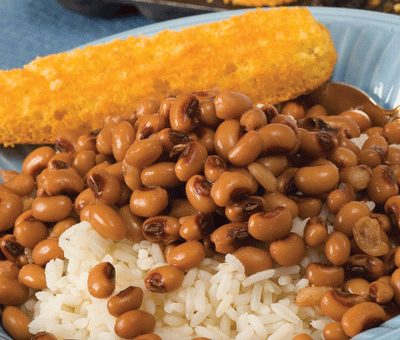 New Year’s Day is a holiday full of traditions and superstitions — especially in the South. As the new year dawns, many people consider it important to do what they can to ensure that it will be a good one. One of the most common ways to do this is through the food served on New Year’s Day. In Fayetteville. the superstitious (and the hungry) can cover all their bases at one of the long-standing traditions; the Black-Eyed Pea Dinner. Truly, it is as much about tradition, friendship and service to the community, but the “lucky” foods add an element of fun to the day. The Black-Eyed Pea dinner began in the ‘70s with Sherriff Ottis F. Jones but in recent years has been carried on by Register of Deeds Lee Warren as his way of giving back to the community.
New Year’s Day is a holiday full of traditions and superstitions — especially in the South. As the new year dawns, many people consider it important to do what they can to ensure that it will be a good one. One of the most common ways to do this is through the food served on New Year’s Day. In Fayetteville. the superstitious (and the hungry) can cover all their bases at one of the long-standing traditions; the Black-Eyed Pea Dinner. Truly, it is as much about tradition, friendship and service to the community, but the “lucky” foods add an element of fun to the day. The Black-Eyed Pea dinner began in the ‘70s with Sherriff Ottis F. Jones but in recent years has been carried on by Register of Deeds Lee Warren as his way of giving back to the community.
“The menu includes a great traditional southern meal of black-eyed peas, collard greens, candied yams, bar-b-que, tea and coffee and it is all topped off with some great live Southern Gospel music. Bring the kids out to see Truman from Kidsville News!” said Warren. “It is a lot of fun seeing old friends every year and making sure that no one has to cook on New Year’s Day.”
The tradition of eating black-eyed peas on New Year’s Day goes back many years in the South, but it may have originated in even older cultures. In Jewish culture, in Babylonia circa 500 AD, black-eyed peas were commonly eaten as good luck symbols to celebrate Rosh Hashana, which is the Jewish New Year. This tradition likely made its way to the southern United States through the Sephardic Jews. This group immigrated to Georgia in the 1730s. The popularity of these peas in general can be traced to the Civil War. In the early 1860s, black-eyed peas were only fed to livestock, but when the Union armies came through the South and burned all of the other crops, the peas were eaten out of necessity. The drought resistance also made the peas a popular crop in difficult years. Traditionally these peas are intended as a symbol for prosperity in the coming year, representing coins and swelling in size as they cook. There are also several sayings that are associated with this belief in lucky peas centering around the idea that the act of eating humbly on New Year’s promising better food in the year to come. One common phrase is “Eat poor on New Year’s, and eat fat the rest of the year.” Black-eyed peas are usually prepared with pork, which is considered lucky because pigs are known to root forward when they forage.
Collard greens are another southern New Year’s tradition aimed at bringing luck and prosperity to a family. Collards had a rise in popularity thanks to the Civil War, too. The Union Army left behind these crops, and considered them animal food, but they are packed with valuable nutrients. As far as bringing prosperity on New Year’s Day, the collard’s symbolism is quite easy to see. Thanks to their leafy green appearance they represent paper money. Green is also a color symbolic of hope and growth, both valuable traits for a new year.
The dinner starts at 11 a.m. on New Year’s Day, at the Crown and is free to the public. The dinner grows every year and it is a great way to meet people from the community. Not only will the food be delicious, but also the fellowship and friendship will be an incredible way to start the new year.
Photo: Don't miss the New Year's Day Black-Eyed pea dinner.